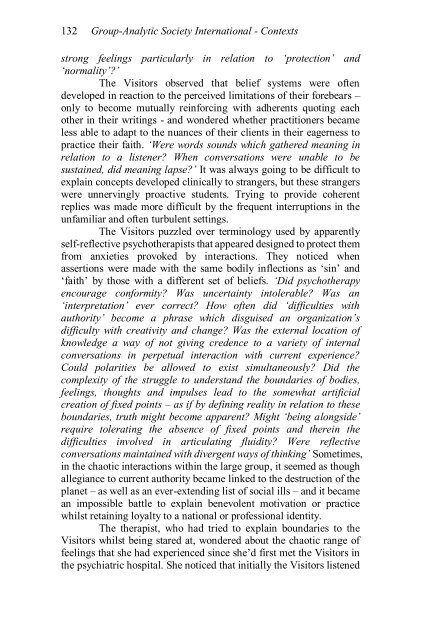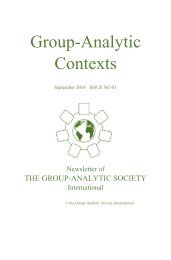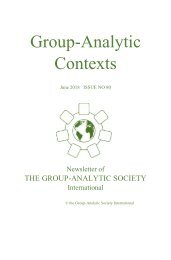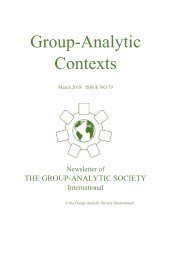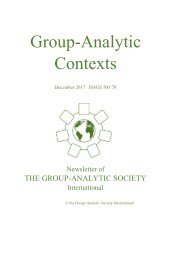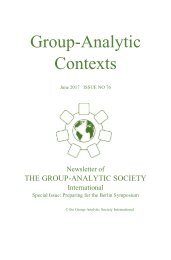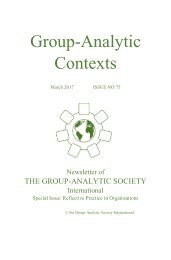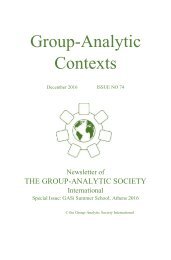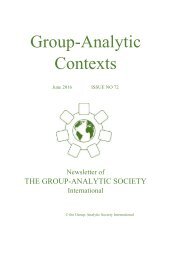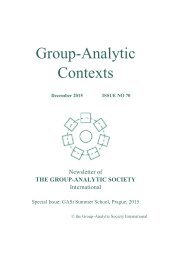Group Analytic Contexts, Issue 77, September 2017
Newsletter of the Group Analytic Society International
Newsletter of the Group Analytic Society International
You also want an ePaper? Increase the reach of your titles
YUMPU automatically turns print PDFs into web optimized ePapers that Google loves.
132 <strong>Group</strong>-<strong>Analytic</strong> Society International - <strong>Contexts</strong><br />
strong feelings particularly in relation to ‘protection’ and<br />
‘normality’?’<br />
The Visitors observed that belief systems were often<br />
developed in reaction to the perceived limitations of their forebears –<br />
only to become mutually reinforcing with adherents quoting each<br />
other in their writings - and wondered whether practitioners became<br />
less able to adapt to the nuances of their clients in their eagerness to<br />
practice their faith. ‘Were words sounds which gathered meaning in<br />
relation to a listener? When conversations were unable to be<br />
sustained, did meaning lapse?’ It was always going to be difficult to<br />
explain concepts developed clinically to strangers, but these strangers<br />
were unnervingly proactive students. Trying to provide coherent<br />
replies was made more difficult by the frequent interruptions in the<br />
unfamiliar and often turbulent settings.<br />
The Visitors puzzled over terminology used by apparently<br />
self-reflective psychotherapists that appeared designed to protect them<br />
from anxieties provoked by interactions. They noticed when<br />
assertions were made with the same bodily inflections as ‘sin’ and<br />
‘faith’ by those with a different set of beliefs. ‘Did psychotherapy<br />
encourage conformity? Was uncertainty intolerable? Was an<br />
‘interpretation’ ever correct? How often did ‘difficulties with<br />
authority’ become a phrase which disguised an organization’s<br />
difficulty with creativity and change? Was the external location of<br />
knowledge a way of not giving credence to a variety of internal<br />
conversations in perpetual interaction with current experience?<br />
Could polarities be allowed to exist simultaneously? Did the<br />
complexity of the struggle to understand the boundaries of bodies,<br />
feelings, thoughts and impulses lead to the somewhat artificial<br />
creation of fixed points – as if by defining reality in relation to these<br />
boundaries, truth might become apparent? Might ‘being alongside’<br />
require tolerating the absence of fixed points and therein the<br />
difficulties involved in articulating fluidity? Were reflective<br />
conversations maintained with divergent ways of thinking’ Sometimes,<br />
in the chaotic interactions within the large group, it seemed as though<br />
allegiance to current authority became linked to the destruction of the<br />
planet – as well as an ever-extending list of social ills – and it became<br />
an impossible battle to explain benevolent motivation or practice<br />
whilst retaining loyalty to a national or professional identity.<br />
The therapist, who had tried to explain boundaries to the<br />
Visitors whilst being stared at, wondered about the chaotic range of<br />
feelings that she had experienced since she’d first met the Visitors in<br />
the psychiatric hospital. She noticed that initially the Visitors listened


